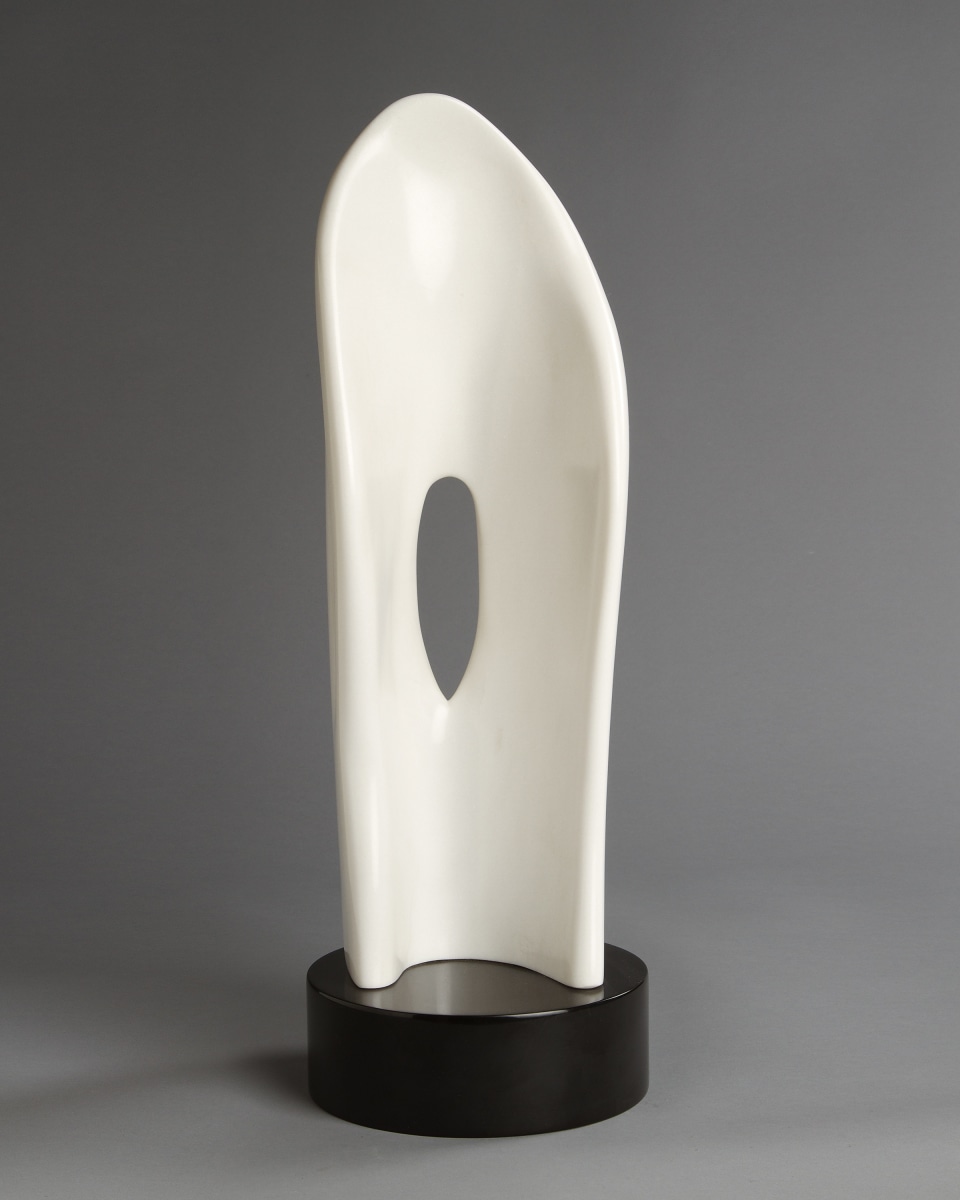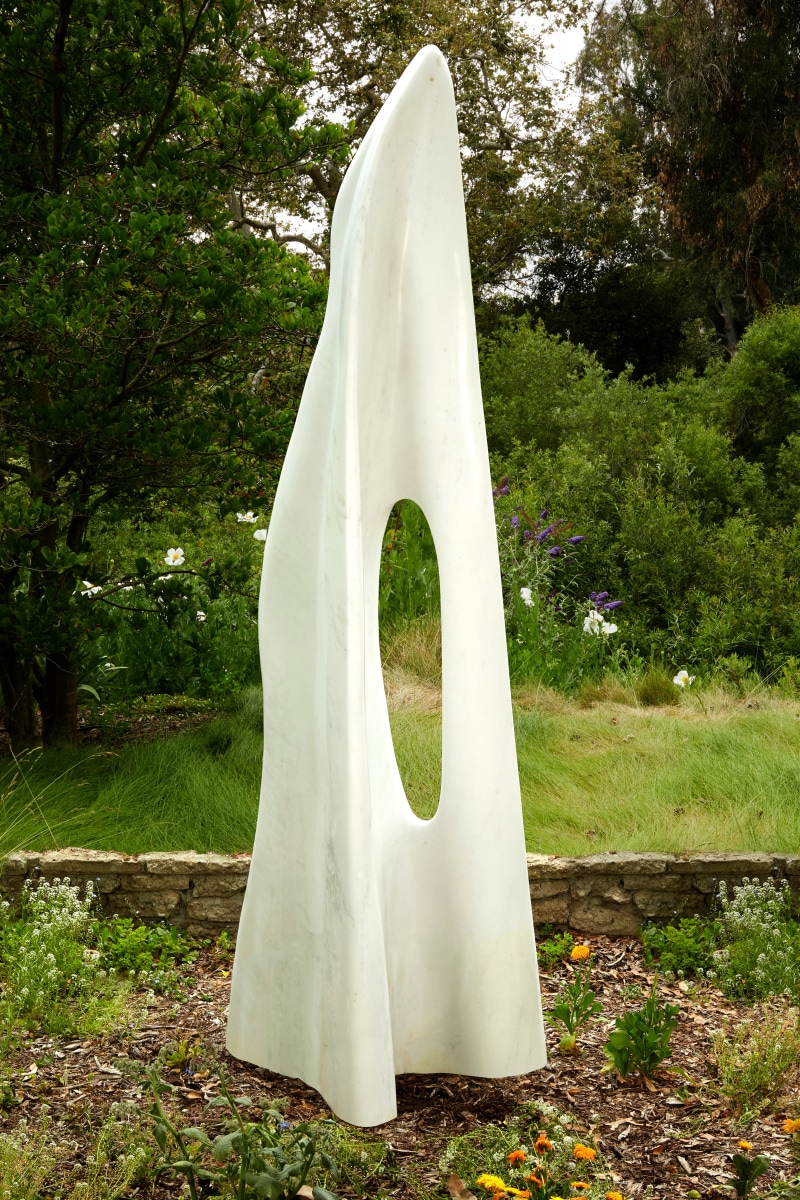Charlie Kaplan: Contours
A Dialogue between the Artist and the Stone, Catalogue Essay by Sandra Kraskin
2019


White Shroud, 2003
Statuario Carrara Marble
20" X 6"
A Dialogue between the Artist and the Stone
by Sandra Kraskin
Curving like mountains or waves, Charlie Kaplan’s sculptures echo the organic forms of nature. His work appears monumental whether it’s massive like Soaring, which rises nine feet, or much smaller like Black Slice, which is only 28 inches high. The marble, Kaplan’s favored material, imparts a timeless quality to his sculptures. It also provides a natural color that adds a unique beauty and a specific identity to each piece. As Kaplan, himself, explains, “My ideas come from the stone.” Because he carves directly, without a sketch as a guide, Kaplan is responding to the individual characteristics of each piece of stone, almost like he would to a spoken command. The stone is speaking to him, and he is following its imperatives.
When Kaplan begins the conversation, he chooses a rock, not a rectangular block of stone. He removes the sections that have cracks or faults, and then he chisels out a small area while following the natural contours of the marble. As he expands the form, he maintains a dialogue in which he continues to react to the inherent structure of the stone. Kaplan speaks of a process that is intuitive: “I look for a pleasing curve in an area that I can develop. I turn the stone over and keep working until I can unite all the sides.”2Evaluating the traits of his stone, Kaplan follows not only his own instinct, but also the path the stone’s markings, shape, and texture suggest for him. This back and forth conversation allows Kaplan to make decisions and to establish a process he can employ to translate abstract ideas into concrete form.
Embracing Abstract Art
As a modernist, Kaplan has been inspired by the massive sculptures of Henry Moore and the simplified forms of Constantin Brancusi. His sculptures also recall the organic, curvilinear shapes and the automatic process of the European modernist, Jean (Hans) Arp. Kaplan visualizes his forms in the abstract tradition of the first half of the 20th century. When he began experimenting with sculptural forms, he rejected the long tradition of figurative sculpture and ignored the aggressive commercial images and process of the Pop artists who dominated the art world in the 1960s. His spontaneous approach, his encounter with stone, is more akin to the automatic process used by the Abstract Expressionist artists in the 1950s and 1960s.
A Passion for Sculpture
While Kaplan was working in business in the late 1960s, he began experimenting with sculpture, using a set of chisels to carve wood. In 1969, he enrolled in a sculpture course at Beverly Hills Adult School, where he learned to model with clay and wax. He also studied at Santa Monica City College, taking courses in welding and blacksmithing. In 1978, Kaplan enrolled in the extension school at UCLA to work with alabaster and marble. After a decade of exploring various materials and techniques, he became captivated by the smooth, sensual surface of marble. He credits Mary Ann DeVine at UCLA Extension and Charles Fulmer at American Jewish University, both in Los Angeles, for his early training in stone carving.
In 1995, Kaplan visited Pietrasanta, a village in Tuscany, Italy, where he studied with Lynne Streeter and met a community of sculptors and Italian artisans who helped to guide him with his work in marble. Located near the renowned quarries of Carrara (where artists including Michelangelo have found their marble for centuries), Pietrasanta became a second home for Kaplan. He returns to Pietrasanta each summer.

Soaring, 2018
Bianco Puro Carrara Marble
108" × 36"
Collection William and Anita Newman Library at Baruch College
Seeking Answers from the Stone
Much of the marble Kaplan selects comes from a quarry at Carrara. In his luminous sculpture, White Shroud, 2007, 56” x 13”, Kaplan worked intuitively, carving a large, but human scale silhouette of white Carrara marble. To deflect the ominous quality of the massive stone, he opened an oval shape in the center, which lightened its form. Again, he responded to the distinctive attributes of the stone, in this case its mass, and answered with a bold retort. Although he did not set out to fashion a shroud — Kaplan names his works after they are finished — this sculpture does, indeed, evoke an image that could cloak a figure.
Pearl Island, 2010, 16” x 8”, a smaller but powerful form, seems to twist and rise with its upward pointing peak. At the same time, its contours undulate, adding movement and softening the appearance of the hard, white stone. The bulk of Pearl Island has been lightened by the removal of marble along its central spine, which also generates a dark interior shadow. Yet, this sculpture still seems to be expanding. Is it the memory of a wave uncovering the edge of an island or a growing organism? Kaplan does not provide specific answers, but encourages us to envision a living entity. Like Brancusi, he searches for the essence, not the outward appearance, of nature.
The bifurcated apex of Dark Sweeping Points, 2016, 25.2” x 15”, leads the eye upward and then separates, pointing in opposite directions. Dark and sleek, the alluring black Belgian marble reflects light like a beacon. The title suggests a purely abstract subject, yet the sculpture itself conjures images of flora or fauna; Kaplan’s vision continues to be a meditation on nature.
Exhibitions and Installations
Charlie Kaplan has exhibited his work internationally. In 2009, his sculpture, Flight, was installed in Pietrasanta on the town’s public pier for the second annual public art exhibit. In 2012, Kaplan exhibited in a solo show at PYO Gallery in Los Angeles, California. Four years later, in 2016, the Museo Gigi Guadagnucci featured his work in a solo exhibition in Massa Carrara, Italy, and in 2018, he exhibited in a solo show in New York City at the Sidney Mishkin Gallery of Baruch College. Kaplan was also chosen to participate in the CibartFestival in Seravezza, Italy in 2017, 2018, and 2019. In addition to his 2019 show at Long-Sharp Gallery in New York, Kaplan’s work will be presented at the Long-Sharp Gallery in Indianapolis, Indiana.
At Baruch College, Kaplan’s dramatic, large sculpture, Soaring, 2012, 108” x 36,” will be installed in the library. Carved from Bianco Puro Carrara Marble, it is a highlight of the College’s modern and contemporary collection. Aldemaro Romero, Dean of the Weissman School of Arts and Sciences, is pleased that Soaringwill be featured in Baruch’s William and Anita Newman Library. He notes that, “This beautiful marble sculpture will capture the attention of students and other visitors to our library, and it will add an important opportunity for the cultural education we wish to provide for our students at Baruch. Installed with a selection from our collection, it will be part of an exhibition throughout the campus that includes work by Robert Rauschenberg, Ellsworth Kelly, Louise Nevelson, Elizabeth Murray, Lynda Benglis, Martin Puryear, and Ursula von Rydingsvard.”3
Extending the Conversation
As a visiting artist, Charlie Kaplan extends his discourse to include students. He has taught at the Corcoran College of Art and Design, Washington D.C. in 2013 and 2014, Bard GraduateCenter, New York City in 2016, and the Noguchi Museum in Long Island City, New York, in 2017.
Demonstrating his carving process, Kaplan works on a piece of marble so students can see how he reshapes a rock into a work of art. He describes his technique and decision-making process as he works. He always encourages his students, who are often intimidated by the difficulty of carving, to learn from the stone. When Kaplan discusses his work with viewers at an exhibition of his sculpture, he provides white gloves and asks them to feel the smooth surface of the marble and the curves that he has formed. In both his own work and in his discussions with others, he emphasizes the revelations that guide him as he draws his ideas from the structural reactions of the marble.
For the past 40 years, Charlie Kaplan has been conversing with stone. The dramatic sculptures in his show at Long-Sharp Gallery visualize this ongoing dialogue: his questions, provocations, arguments, and their resolutions. Now, viewers are challenged to decipher these conversations, not just to look at, but also to listen to this remarkable work.
1 Charlie Kaplan, Interview with Sandra Kraskin, June 6, 2019. Telephone interview.
2 Kaplan, Interview with Sandra Kraskin.
3 Aldemaro Romero, Statement about Installation of Kaplan’s Sculpture at Baruch. June 5, 2019. Email statement.